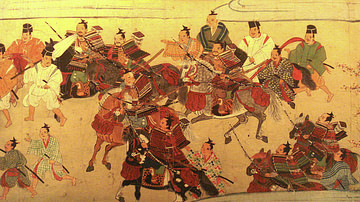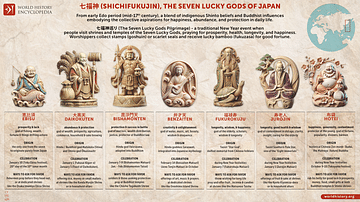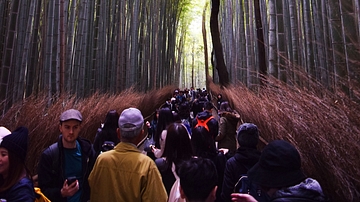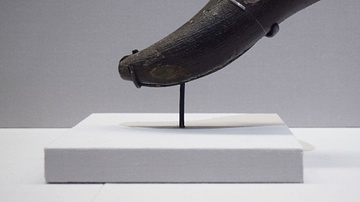Search
Did you mean: Copan?
Search Results

Definition
Muromachi Period
The Muromachi Period (Muromachi Jidai, 1333-1573 CE) refers to the period of Japanese medieval history when the Ashikaga shogun capital was located in the Muromachi area of Heiankyo (Kyoto). Replacing the Kamakura Shogunate (1192-1333 CE...

Image
The Seven Lucky Gods of Japan
An infographic about Shichifukujin, or the Seven Lucky Gods (Seven Gods of Fortune) of Japan, a revered group of deities associated with prosperity and good fortune. Each god represents different blessings, including wealth, happiness, and...

Image
The Portuguese in Japan
A Japanese painted screen by Kanō Naizen showing a Portuguese carrack ship and traders. The Portuguese controlled the trading port of Nagasaki from c. 1571 to 1639. (Kobe City Museum, Japan)

Image
The Mongol Invasion of Japan
"The Mongol Invasion" is a Japanese silk tapestry by Kawashima Jimbei II (Japanese, 1853 - 1910 CE), based on an oil painting by Morizumo Yugyo (1854 - 1927 CE). The painting depicts the Mongol Empire's failed invasions of Japan in in 1274...

Quiz
Feudal Japan
Feudal Japan Medieval Regent Figurehead Shinto Clan Court Zen Buddhism Daimyo Samurai Shogun Bushido Ronin Wako Kana system Za Kamikaze

Image
Arashiyama Bamboo Forest in Japan
The Arashiyama Bamboo Forest or "Sacred Grove" is located in Arashiyama, Japan. Arashiyama and the adjoining Sagano area first became popular during the Heian period when courtiers and the imperial family sought privacy and seclusion away...

Image
Sutra Case from Heian Period Japan
This sutra case was excavated at Hatogamine in Kyoto, Japan. It is made of gilt bronze and dates to the 1116 CE, which was during the Heian period in Japanese history. (Tokyo National Museum)

Image
Fushimi Inari Shrine in Kyoto, Japan
The Fushimi Inari Shrine near Kyoto (Heiankyo), Japan is the largest and most important shrine dedicated to Inari, the Shinto god of rice and prosperity. The shrine was founded in 711 CE by the Hata clan and moved from its original location...

Image
Doban Clay Tablet from Japan
This doban or clay tablet is from the Fukuda Shell Mound in what is present-day Ibaraki prefecture, Japan. It dates from the Jomon period, between 1000-400 BCE. Important cultural property. (Tokyo National Museum)

Image
Horn-shaped Vessel from Japan
This ancient horn-shaped vessle was excavated at Shishuzuka Tumulus, which is located in Mihamacho, Fukui prefecture, Japan. It dates from the 6th century CE, during the Kofun period. (Tokyo National Museum)